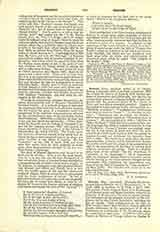

Craven, MRS. AUGUSTUS (PAULINE-MARIE-ARMANDE-AGLAE-FERRON DE LA FERRONNAYS), b. April 12, 1808, in London; d. in Paris, April 1, 1891. Her parents, Comte Auguste-Marie de la Ferronnays, of old Breton stock, and Marie-Charlotte-Albertine de Sourches de Montsoreau, likewise of ancient family, had undergone all the miseries attendant on the emigration during the French Revolution, including the loss of estates. Their attachment to the Duc de Berri brought about their return to France, followed shortly afterwards by the appointment of M. de la Ferronnays as ambassador to St. Petersburg, where he continued for eight years. In 1827 he returned to France as Minister of Foreign Affairs to Charles X.
and Pauline was introduced into the brilliant society of the Restoration. In 1830 her father was given the post of ambassador to Rollie, where he was accompanied by his family. It was probably in Naples that she met Augustus Craven, son of Keppel Craven and grandson of the Margravine of Anspach, who in 1830 had been appointed attached to the British Legation at Naples. Their marriage was celebrated, August 24, 1834, in the chapel of the Acton Palace, Naples, and a few days afterwards Augustus Craven was received into the Church. In 1836 Mr. and Mrs. Craven returned to England, whence they went successively to Lisbon, Brussels (1838), and Stuttgart (1843), where Mr. Craven held diplomatic appointments. Up to this time Mrs. Craven’s life had been intimately bound up with those of her immediate family, whom the world has come to know and love in the pages of “Le Recit d’une Soeur”. She took a keen interest in English politics, and in 1851 wrote a protest against an attack in the House of Commons on conventual life as it was being revived in England.
In 1851 Mr. Craven made an unsuccessful stand for Parliament, which caused him severe financial losses. In 1853 the Cravens took up their residence at Naples in the Palazzino Chiatamone, or as it came to be called, the Casa Craven, formerly occupied by Mr. Craven’s father, who had died in 1851. During the years that followed, this became the center of the brilliant Neapolitan society depicted in Mrs. Craven’s “Le mot de l’enigme”. By 1864 she had arranged the mass of materials for “Le Recit d’une Soeur”, and had begun “Anne Severin”. “Le Recit” appeared in January, 1866. In March, 1868, the first part of “Anne Severin” began in “Le Correspondant”, and Lady Fullerton commenced the translation.
The winters of 1868-69 and 1869-70 were spent in Rome, and at the Craven apartments numbers of distinguished people met, among them many of the prelates present at the Vatican Council. Mrs. Craven’s best known novel, “Fleurange”, appeared in 1872 simultaneously at Paris in “Le Correspondant” and at New York in English through the efforts of Father Hecker in “The Catholic World”. This work was crowned by the Academy. It was followed in 1874 by “Le mot de l’enigme”. In the same year Mrs. Craven’s answer to Gladstone’s article in the “Contemporary Review”, entitled “Ritualism and Ritual“, and his subsequent pamphlet, appeared in “Le Correspondant” on the same day as Cardinal Newman’s “Letter to the Duke of Norfolk”.
After 1870 Mrs. Craven’s life was spent chiefly in Paris, varied by lengthy visits to English friends, and more particularly to Monabri, the beautiful chalet of Princess Sayn Wittgenstein, between Lausanne and Ouchy, where the Empress Augusta was also a frequent guest. The life of Natalie Narischkin, on which Mrs. Craven had long been at work, appeared in 1876. Mr. Craven died at Monabri, October 4, 1884, and was buried at Boury. During the remaining seven years of Mrs. Craven’s life she was busy with various articles for reviews, but chiefly with her last novel, “Le Valbriant”, and the life of her friend, Lady Georgiana Fullerton, published in 1888, and adapted by Father Coleridge in his life. On June 5, 1890, she was attacked by a species of paralysis, which after ten months, during which she was deprived of speech, resulted in her death.
F. M. RUDGE

